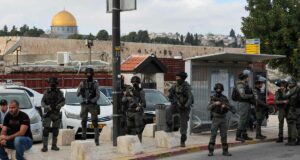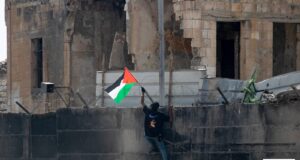Iris Leal | Ha’aretz
11 June 2009
The three days of mourning over the death of Yusuf “Akal” Srour, who was shot at close range on Friday during a demonstration against the separation fence in Na’alin, ended Tuesday. Srour was shot when he tried to help another demonstrator who had been hurt by the soldiers’ fire. The condition of that demonstrator, a boy of 15 from the village of Na’alin, is still serious. He underwent surgery and one of his lungs was removed.
In the past year there have demonstrations in Na’alin every Friday. In neighboring Bil’in, the residents have been demonstrating since 2005, when the construction of the barrier on their land began. In spite of a High Court of Justice ruling on September 4, 2007, which proposed that, within a reasonable period of time, a plan be considered to reroute existing and planned sections of the fence to reduce harm to the villagers, with preference to be given to construction on state land; and despite a subsequent ruling, after nothing was done, declaring that security considerations do not justify maintaining the route along its present line, and ordering the respondents to act on the court’s decisions without delay – the fence is still in the same place, separating the village from its land.
On the way to Na’alin, from Highway 443, one can observe the dance of the unattractive cranes that are industriously building the city of Modi’in. From the Shilat junction, one can see the depressing results of construction beyond the Green Line. It is hard to describe the ugliness of the new neighborhood there, Matityahu East, and upsetting to think about Modi’in Ilit, to which it belongs. Suffice it to say that this is misanthropic architecture, inhospitable to its residents, who are large ultra-Orthodox families, and to its rocky surroundings as well.
It is even harder to grasp that from the land on which these huge stone boxes with their fiberglass balconies are now sprouting, only four and a half years ago silvery olive trees and apricot trees grew – the livelihood of farmers from neighboring Bil’in, who now have the separation fence stuck in their throats.
It’s noontime on Friday, and most of the village residents are still at the mosque, in the midst of prayers. A large sign demands of the president of the United States, in English: “Have a look.”
One can only guess what the locals expect Barack Obama to see, the day after his speech in Cairo: perhaps the separation fence that passes through the backyard of a home, the agricultural land that lies on the other side, or the fresh grave of Bassem Abu Rahmeh, who was killed by a gas grenade that hit him during a regular Friday demonstration a month earlier. Palestinian flags and a tiny palm tree adorn his grave in the plot of the shaheed (martyrs) in the center of the village. Children energetically engaged in commerce momentarily stop selling cups of coffee and bracelets embroidered with the Palestinian flag, to tell people gathering next to the wall, before the weekly Bil’in demonstration, the story of Abu Rahmeh’s death in three languages.
Information begins to be exchanged as an essential part of the preparations. Haaretz photographer Tomer is delighted to see his friend Oren, who is setting up his own photographic equipment. Tomer has heard that they have improved the quality of the tear gas. Oren then tells him about the new device that fires 64 tear-gas grenades at once. And what about the stink bomb? Tomer has been talking about it all the way to Bil’in because he’s heard that it’s impossible to get rid of the stench for days – only immersion in the sea helps somewhat. But his friend who goes to either Bil’in or Na’alin every week and is therefore an authority on the matter, says he has not encountered it.
‘Goodbye Bassem’
Across the way, at the entrance to the grocery store, sits Abdullah Abu Rahmeh, who introduces himself to me as the “coordinator of activities of Bil’in’s Popular Committee Against the Wall and the Settlements.”
“Yesterday was great,” he says without enthusiasm. “People came from all over the territories, they came from Jenin, from Hebron, to send a message to Obama that we want deeds and not words.”
A practical man, tall and mustachioed, he wears a shirt that says “Goodbye Bassem,” with a picture of the dead man in terra-cotta hues.
From the direction of the mosque Mohammed Khatib approaches. He takes a stool and crowds in next to us in a small patch of shade, particularly precious during the hot midday hours. He has played a substantial part in the prolonged media coverage of Bil’in’s struggle against the separation fence. Indeed, one could say that Khatib is the dramaturge of the struggle, the one who comes up with the theme of the protest processions. During the Soccer World Cup three years ago, they wore the uniforms of soccer teams; on Christmas, they dressed up as Santa Claus. Occasionally the demonstrators have tied themselves to olive trees, while at other times they entered the tanks that supply the village with water – a reference to the popular story by Ghassan Kanafani “Men Under the Sun.” Khatib is a person who succeeds in maintaining his good spirits even on terrible days, as this one will be in the end.
The imam is reaching the end of his sermon and soon the procession will set out, as it does every Friday. I ask Khatib if he is nervous.
“Each time we go to a demonstration, we’re never sure we’ll return to our families,” he replies calmly, “although it’s not a violent demonstration and although there is a specific order not to shoot with live fire. In the end it’s their finger on the trigger. I was next to Bassem a month ago, it could have been me. We clearly understand that we are living very close to death and are getting closer to it all the time.”
Khatib’s prosaic manner is highly polished and he excels at creating dramatic moments – a talent I can appreciate, although at the same time I am wary of it: the exaggeration, the love of spectacle and the longing for the impossible constitute the necessary romantic foundation for struggles of this kind.
Equipped with bottles of water, we set out: A huge loudspeaker is perched on the back of a pickup truck, broadcasting praises of the latest shaheed. Palestinian flags are flying high. I march alongside Talila, Bassem’s friend, who has been coming here every week for the past two years. And then it is revealed to us in all its glory – the separation fence, a lattice of iron behind which Israel Defense Forces soldiers are patrolling while waiting for the weekly encounter. Beyond them, as if in defiance, are the agricultural fields of contention.
“You can’t get to your lands at all?” I ask Basman Yassin, a farmer who shows an interest in my yellow notebook and the pen hovering above it. He says that in theory, with the proper permits – which are a pain in the neck to obtain – there is access to the land, but in practice it is often denied for prolonged periods. Crops do not tolerate caprices, they demand regularity.
What is a regular feature here, however, is the following ritual: A barrage of gas grenades is fired at the people leading the procession while they are still a considerable distance from the fence. A double “tak-tak” sound and after it a murmur, like when the air is let out of a tire. One such sound signals the use of a rubber bullet, like the one a boy gets in his leg that day. Thus, without any provocation and in a single moment – and it’s hard to understand what sets it apart from all the moments that preceded it – a white cloud that smells like a discharged cap gun and tastes bitter descends upon the dirt path and the protestors.
“Tear gas is an emotional state,” explains Khatib, his eyes red and teary. “The most important thing is to become emotionally strong.”
We decide to approach the fence from the right side, in order to speak to the soldiers, and so we cross the olive grove. Through my gas mask, the situation becomes even more conflicted: Who are the men in uniform, whose rubber bullets and stun grenades and tear gas are scaring me, and why are they speaking to me in Hebrew?
“Hey, bro’,” shouts Tomer, the photographer. “Why are you throwing a stun grenade – don’t you see I have a camera?”
“We didn’t notice,” comes the answer.
At this same time, the army is making widespread use of weapons in Na’alin. “They arrived before prayers and tried to take over a building with dozens of gas grenades,” Yonatan Pollack, founder of Anarchists Against the Fence, tells me the next day. “There were clashes that calmed down when the Friday prayers began. As soon as the procession set out, at a distance of a kilometer from the fence, the army began to attack from inside the village.”
According to Pollack, live fire, the use of which is restricted to certain situations, was used.
Back in Bil’in, we are refreshing ourselves with cans of cola when Khatib informs us: “There’s a shaheed in Na’alin.”
Later I ask Khatib: What’s the story of the water tanks and “Men Under the Sun”?
“Ah,” he says, “it’s the story of a Palestinian refugee who is looking for work, and for that purpose tries to sneak over the border between Iraq and Kuwait. Together with another three men, he hides in water tanks being delivered by a truck. It’s the desert, in mid-July. The truck driver is stopped for questioning at the border. While he is trying to allay the suspicions of the soldiers, the men suffocate from the heat inside the tanks and die.
“They didn’t dare bang on the sides of the tank, or call for help, because they were afraid of being caught,” says Khatib, explaining the moral of the story. “But we refuse to die quietly.”
Iris Leal’s most recent book, “Home Fires Blazing” (in Hebrew), was published by Kinneret Zmora Bitan.
 International Solidarity Movement Nonviolence. Justice. Freedom.
International Solidarity Movement Nonviolence. Justice. Freedom.


